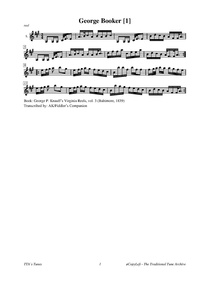Template:Pagina principale/Vetrina: Difference between revisions
No edit summary |
No edit summary |
||
| Line 1: | Line 1: | ||
{{SheetMusic | {{SheetMusic | ||
|f_track= | |f_track=George Booker.mp3 | ||
|f_pdf= | |f_pdf=George Booker.pdf | ||
|f_artwork= | |f_artwork=George Booker Grave.jpg | ||
|f_tune_name= | |f_tune_name=George_Booker_(1) | ||
|f_track_title= | |f_track_title=George Booker | ||
|f_section=abc | |f_section=abc | ||
|f_played_by=[https://soundcloud.com/ | |f_played_by=[https://soundcloud.com/trad-tune-collection Fionnlagh Ballantine] | ||
|f_notes= | |f_notes= Revolutionary War citizen patriot George Booker’s grave marker. | ||
|f_caption= | |f_caption=Researcher Chris Goertzen elaborates that this George Booker served as a militia lieutenant in the Revolutionary War and lived in Knauff's area of Farmville, Virginia; probably the same individual who was a local lawyer by 1809. | ||
|f_source=[https://soundcloud.com/trad-tune-collection/reel-george-booker Soundcloud] | |||
|f_source=[https://soundcloud.com/ | |||
|f_pix=420 | |f_pix=420 | ||
|f_picpix=200 | |f_picpix=200 | ||
|f_article=[[ | |f_article=[[George_Booker_(1)| '''George Booker''']] | ||
The | The melody first appears under the "Booker" title in George P. Knauff's '''Virginia Reels''', volume III (Baltimore, 1839), apparently in honor of a Revolutionary War leader and local hero from Virginia (according to Jabbour). Researcher Chris Goertzen elaborates that this George Booker served as a militia lieutenant in the Revolutionary War and lived in Knauff's area of Farmville, Virginia; probably the same individual who was a local lawyer by 1809. Goertzen points out that the Booker family name "is common in the little cemeteries that dot Prince Edward County farms" <ref>Chris Goertzen,'''George P. Knauff's Virginia Reels and the History of American Fiddling''', 2017, p. 65.</ref>. Bruce Green thinks this tune may have been brought to the southern Kentucky region by a fiddler named John Gregory, originally from Virginia (in connection with similar Kentucky melodies, see Ed Hayley's "[[Grey Eagle Jig]]"). The tune was recorded for the Library of Congress by musicologist/folklorist Vance Randolph in the early 1940's from Ozarks Mountains fiddlers (including Lon Jordan in 1941), although Drew Beisswenger (2008) says it is not often played by Ozarks fiddlers today. Alan Jabbour believes "George Booker" is similar to "[[Camp Chase]]" and speculates that the former may have been the tune originally played in the Civil War prison camp which gave West Virginia fiddler Solly Carpenter his freedom. | ||
< | |||
}} | }} | ||
Revision as of 10:01, 11 March 2023

Played by: Fionnlagh Ballantine
Source: Soundcloud
Image: Revolutionary War citizen patriot George Booker’s grave marker.

The melody first appears under the "Booker" title in George P. Knauff's Virginia Reels, volume III (Baltimore, 1839), apparently in honor of a Revolutionary War leader and local hero from Virginia (according to Jabbour). Researcher Chris Goertzen elaborates that this George Booker served as a militia lieutenant in the Revolutionary War and lived in Knauff's area of Farmville, Virginia; probably the same individual who was a local lawyer by 1809. Goertzen points out that the Booker family name "is common in the little cemeteries that dot Prince Edward County farms" [1]. Bruce Green thinks this tune may have been brought to the southern Kentucky region by a fiddler named John Gregory, originally from Virginia (in connection with similar Kentucky melodies, see Ed Hayley's "Grey Eagle Jig"). The tune was recorded for the Library of Congress by musicologist/folklorist Vance Randolph in the early 1940's from Ozarks Mountains fiddlers (including Lon Jordan in 1941), although Drew Beisswenger (2008) says it is not often played by Ozarks fiddlers today. Alan Jabbour believes "George Booker" is similar to "Camp Chase" and speculates that the former may have been the tune originally played in the Civil War prison camp which gave West Virginia fiddler Solly Carpenter his freedom.
...more at: George_Booker_(1) - full Score(s) and Annotations
- ↑ Chris Goertzen,George P. Knauff's Virginia Reels and the History of American Fiddling, 2017, p. 65.
